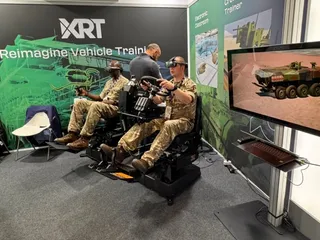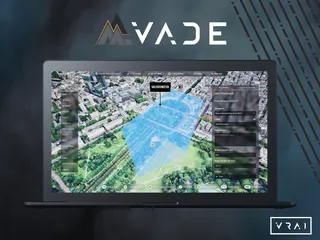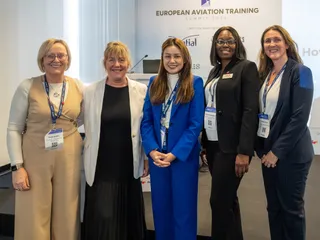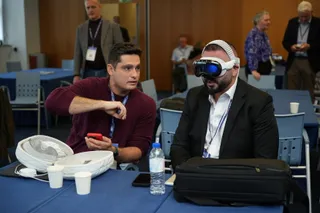XRT Accelerates Crew Training with AI
Contact Our Team
For more information about how Halldale can add value to your marketing and promotional campaigns or to discuss event exhibitor and sponsorship opportunities, contact our team to find out more
The Americas -
holly.foster@halldale.com
Rest of World -
jeremy@halldale.com
Sponsored Content
Agile development, adaptive training, and agentic AI are reshaping the future of military training and simulation. As the modern battlefield evolves and vehicle systems grow more complex, new technologies must be deployed quickly to sustain readiness where it matters most.
Flexible acquisition frameworks like the DoD’s Other Transaction Authority (OTA) enable rapid delivery of these innovations to Warfighters – compressing development cycles and fielding capability faster than traditional procurement.
Among these advancements, AI is shifting the paradigm of the immersive training toolkit, creating systems that evolve with the learner.
An AI-Powered Prototype on the Horizon
XRT specializes in delivering deployable, custom-built simulation systems that leverage XR, AI, and modular digital twin architectures within rapid acquisition frameworks such as OTAs. Working with strategic R&D partners, XRT is now preparing to field an AI-enabled Crew Gunnery Trainer (CGT) prototype that provides realistic, repeatable collective mission training.
More than a technology insert, this prototype demonstrates how AI, digital twin technology, and real-time simulation converge into a cohesive, flexible ecosystem aligned with the DoD’s future-force shift toward agile, data-driven, continuously adaptive training that learns from operator input and commander’s intent.
Agility Through the Power of Partnership
The CGT effort reflects XRT’s proven operational model – a curation of multiple specialized partners working as one integrated engine. This decentralized, mission-aligned structure eliminates administrative drag and accelerates capability delivery.
XRT’s collaborative culture turns diversity into fast action, uniting partners with deep expertise in AI, simulation, content, and hardware to drive rapid iteration, constant feedback, and seamless integration. Redshred and Enludio lead AI architecture development, defining how natural-language systems and agentic AI transform training pipelines. Other partners drive our hardware integration and real-time learning management system, creating a modular ecosystem for rapid content creation.
This model enables prime-level performance at startup velocity, connecting innovators who operate like Warfighters to move at “mission speed” - fast, iterative, and accountable.
Turning Orders into Scenarios
A key innovation within the CGT prototype is the use of Retrieval-Augmented Generation (RAG) to reorganize operations orders into simulation scenarios.
In legacy systems, scenario creation is manual and time-intensive. XRT’s AI framework – developed with Redshred and Enludio – removes the bottleneck by using AI to accelerate the process. The system ingests command-level documents such as operations and fragmentary orders, using contextual retrieval and semantic analysis to extract mission objectives, constraints, and environmental factors.
These are transformed into structured scenario parameters (e.g., unit placement, routes, rules of engagement) and rapidly integrated into Unreal Engine, enabling faster creation and iteration with minimal developer involvement. When new orders are issued, the system re-runs the same RAG pipeline to update objectives and tactical context dynamically, compressing scenario build times from days to minutes.
The result is a simulator that reads orders and builds missions on demand, creating training scenarios that evolve in real time with the mission narrative.
AI-Driven Battlefield Communications
While visual realism remains vital, true training immersion requires authentic battlefield communication. The CGT prototype integrates synthetic interactions that mirror the complete command-and-crew dialogue loop—from headquarters to the vehicle and between crew members.
The AI framework processes and interprets real-time voice inputs from the Driver, Vehicle Commander, and Gunner. The simulator distinguishes speakers, understands tactical context, and triggers responses. Verbal commands initiate AI events, activate behaviors, and adjust mission parameters.
Outbound communications are generated synthetically, reflecting authentic radio discipline, stress cues, and even degraded comms to simulate realistic operational friction. This voice-aware layer bridges the gap between procedural and cognitive training, teaching crews to communicate, listen, and adapt under pressure – just as in live operations.
Smarter Targets and Thinking Forces
Beyond communication and scenario generation, the CGT redefines how computer-generated threats and friendlies behave. Targets no longer follow scripted patterns. These AI-driven entities adapt to the situation, leveraging simulated sensors (camera visibility, audio cues, and environmental state) combined with operational intent to drive dynamic decision-making – replicating the uncertainty and adaptability of real combat.
This adaptive behavior challenges crews to think actively, applying doctrine dynamically rather than repeating patterns. Every engagement becomes a decision problem instead of a reflex exercise.
AI agents also model collective force behavior – representing teams, sections, or platoons governed by doctrinal templates. These agents coordinate movement, fire, and reactions to evolving battlefield conditions. When issued a command such as defend, assault, or recon, they execute synchronized maneuvers accordingly.
This intent-driven modeling generates adversaries that behave credibly and adaptively, providing a training challenge that scales from individual crew engagements to full tactical missions against adversaries that learn.
Distributed Architecture for Scalable AI
To make these adaptive AI systems interoperable and future-ready, the CGT employs a distributed architecture. Each AI module – scenario generation, voice analysis, behavior modeling, and force logic – operates as an independent service connected through a unified data fabric.
The distributed architecture executes decision-critical logic at the edge and offloads complex processing to external compute, ensuring low-latency performance within Unreal Engine. This architecture provides flexibility to add new AI modules, content domains, and integration with joint or coalition systems, and can scale from a single-vehicle trainer to networked multi-domain training without re-engineering the foundation.
AI as a Training Partner
Overall, XRT’s CGT prototype is not a proof of concept; it’s evidence of transformation across defense training, demonstrating AI as the next evolution of immersive training via intelligent environments that adapt as operators learn.
When a simulation can read, listen, think, and respond, it ceases to be a passive tool and becomes an active teammate.
As XRT, Redshred, and Enludio prepare to showcase this groundbreaking system, one message is clear – AI in defense training is no longer experimental. It’s operational.
See the CGT at IITSEC Booth #441
XRT and its partners will showcase the Crew Gunnery Trainer OTA prototype at IITSEC 2025. Let’s discuss how RAG, synthetic communications, and AI-driven behavior modeling combine to redefine realism in simulation.
For more information or partnership inquiries, contact Neil Levin, CEO at XRT.IO



